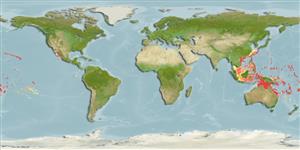Common names from other countries
>
Acanthuriformes (Surgeonfishes) >
Acanthuridae (Surgeonfishes, tangs, unicornfishes) > Acanthurinae
Etymology: Ctenochaetus: Greek, kteis, ktenos = comb + Greek, chaite = hair (Ref. 45335).
More on author: Bennett.
Issue
References with country records other than those from Hawaii and Johnston Islands refer to different species.
Environment: milieu / climate zone / depth range / distribution range
Ecologia
marinhas associadas(os) a recifes; intervalo de profundidade 1 - 113 m (Ref. 42056). Tropical; 21°C - 27°C (Ref. 27115); 23°N - 16°N, 170°W - 154°W
Eastern Central Pacific: endemic to the Hawaiian Islands and Johnston Island.
Length at first maturity / Tamanho / Peso / Idade
Maturity: Lm 14.5 range ? - ? cm
Max length : 15.0 cm SL macho/indeterminado; (Ref. 94645)
Espinhos dorsais (total) : 8; Raios dorsais moles (total) : 25 - 28; Espinhos anais: 3; Raios anais moles: 22 - 25. Yellow on edge of orbit broad and conspicuous (pale in preservative), especially posteriorly. Small spots on head blue, not extending onto anterior body or chest. Posterior gill rakers 30-36 (Ref 42056).
Benthopelagic over coral, rock, and rubble (Ref. 58302). Solitary. Mainly diurnal (Ref. 4887). Feeds on detritus by whisking its comb-like teeth over the bottom as it closes its mouth (Ref. 3921).
Life cycle and mating behavior
Maturities | Reprodução | Spawnings | Egg(s) | Fecundities | Larvas
Spawn in pairs (Ref. 240).
Randall, J.E and K.D. Clements, 2001. Second revision of the surgeonfish genus Ctenochaetus (Perciformes: Acanthuridae), with descriptions of two new species. Indo-Pac. Fish. (32):33 p. (Ref. 42056)
Categoria na Lista Vermelha da IUCN (Ref. 130435)
CITES (Ref. 128078)
Not Evaluated
Ameaça para o homem
Reports of ciguatera poisoning (Ref. 30298)
Utilização humana
Pescarias: espécies comerciais; Aquário: Espécies comerciais
Ferramentas
Relatórios especiais
Descarregue XML
Fontes da internet
Estimates based on models
Preferred temperature (Ref.
115969): 24.4 - 28.9, mean 27.4 (based on 382 cells).
Phylogenetic diversity index (Ref.
82804): PD
50 = 0.5020 [Uniqueness, from 0.5 = low to 2.0 = high].
Bayesian length-weight: a=0.02291 (0.01363 - 0.03849), b=3.03 (2.89 - 3.17), in cm Total Length, based on LWR estimates for this species & (Sub)family-body (Ref.
93245).
Resiliência (Ref.
120179): Elevada, tempo mínimo de duplicação da população menor que 15 meses (K=0.9).
Fishing Vulnerability (Ref.
59153): Low to moderate vulnerability (28 of 100).
